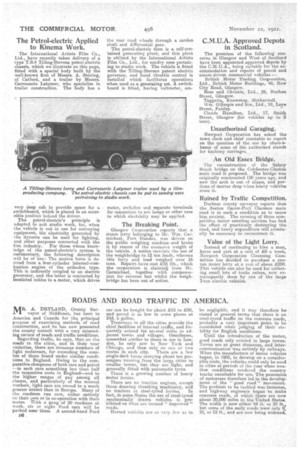ROADS AND ROAD TRAFFIC IN AMERICA.
Page 8

If you've noticed an error in this article please click here to report it so we can fix it.
N[R. A. ]RYLAND, County Sur. veyor of Middlesex, has been to America and Canada for the principal purpose of examining methods of road construction, and he has now presented the county council with a very interesting review of roads and traffic conditions_
Regarding traffic, he says, that oil the roads in the cities, end in their near vicinities, there are immense numbers of light motorcars, far exceeding the number of those found under similar conditions in England. Owing to the comparative cheapness of both cars and petrol —in each case something less than half the respective costs in England—and to the higher ranges of pay among all elassee, and particularly of the manual workers, light ears are owned to a much greater extent than in Europe. Many of the roadmen run cars, either entirely on their awn or in co-operation with their mates_ With a gang of 20 -madmen at work, six or eight Ford cars will be parked near them. A second-hand Ford D8
car can be bought for abOut £15 to £20, and petrol is as low in some places as 10d. a gallon. Tramways in all the cities provide the chief facilities of internal traffic, and frequently extend for several miles to adjacent towns and villages. Omnibuses, somewhat similar to those in use in London, he only saw in New York and Chicago, and then only on one or two routes in each city. There are a few single-deck buses carrying about ten passengers running from the large cities tosmaller towns, but they are light, and generally fitted with pneumatic tyres.
There is a. growing number of heavy motor lorries.
There are no tract-ion engines, except, those drawing threshing machinery, arid no tractors or steel-Wed lorries. rrt fact, in some States the use of steel-tyred mechanically' drawn vehicles is prohibited on whet are termed " improved " roads.
Horsed vehicles are so very few as to be negligible, and it May therefore he -stated in general terms that there is no steel-t-yred traffic on the concrete roads, . probably a very important point to be considered when judging of their stability for English conditions.
Until the introduction of the motor, good roads only existed in large towns. Towns are at great distances, and intercommunication was entirely by railways. When the manufacture of motor vehicles began, in 1905, to develop on a considerable scale, the vehicles could only be used in cities at periods of the year when weathee conditions rendered the country tracks unsuitable for use. The possession of motorcars therefore, led to the development of the " good road" movement. The problem to be tackled was immense, and highway engineers began to make concrete roads, of which there are now about 20,000 miles in the United Staten. The width is now either 18 ft. or 20 ft.„ but, some of the eaely roads .were only 9, 10, or 12 ft., and are now being widened.








































